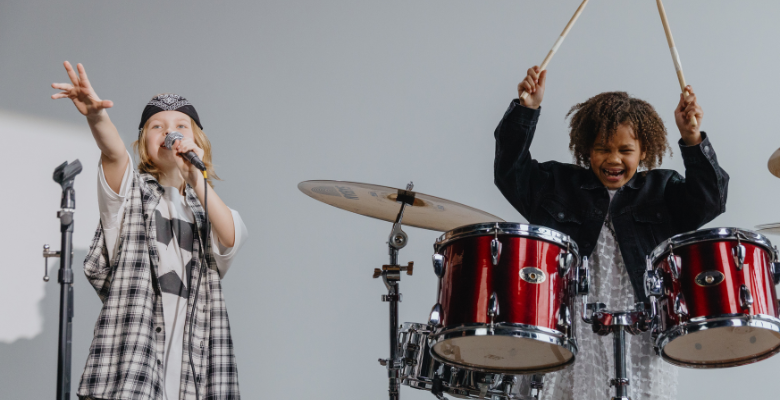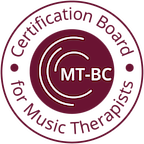If you are a parent or music teacher of an individual with attention issues, music therapy may be an option to consider. Specifically, drumming has been found to be helpful for children with attention disorders because it can help improve focus, self-control, and concentration. This blog post will cover 10 music therapy activities that you can use to teach a teenager drum notation!
Does your child struggle with focusing on learning drum notation? They love the drums and may even be good at them, having a good sense of rhythm and/or a good ear for music, but you find it challenging to help them learn the notation of drumming. This is a common problem across many instruments, as children would like to have more immediate results and struggle with the “bookwork,” so to speak. If your child is interested in the drums, that’s wonderful, because drumming experiences have been proven to be an effective way to improve focus and attention. In fact, as a music therapist, I use drumming to help clients with various non-musical skills that benefit their brain and behavior function in everyday life (speech patterns, memory, motor control, and so much more). However, for individuals interested in going further with drumming and may want to be part of group experiences like a band or symphony, drum notation is foundational. In this blog, I have put together 30 activities that can be used by parents, teachers, and therapists who need inspiration for supporting their child/student/client in learning drum notation but are running into attention and/or learning roadblocks, making traditional methods ineffective. These activities are not only educational, but they’re also enjoyable, making them perfect for individuals who tend to get bored easily.
- Beat the Clock – Divide your class into groups of two and give each group a drum and a sheet of drum notation. Set a timer for a minute, and challenge them to see how much of the notation they can learn and play in that time. The group that achieves more at the end wins.
- Drum Memory Game – Create two sets of drum notation cards with identical patterns and shuffle them. Then, challenge the students to match the patterns by turning over two cards at a time. This game helps improve memory and recognition skills while also reinforcing drum notation.
- Jamming Session – Create a song with a simple drumbeat and encourage the students to improvise different rhythms on top of the base beat. This helps them develop creativity and improvisational skills while also practicing drum notation.
- Pass the Beat – Have the students sit in a circle with class/teacher/therapist and pass a hand drum around. Each participant must add a different drum rhythm to the beat, all while following the drum notation on the board. This game helps them develop coordination skills, and it’s also a lot of fun.
- Drum Charades – Write down a few drumming techniques on cards and have participants act out the drumming technique without making any sound. When a team/individual acknowledges the correct answer, they/he/she receives a point.
- Drumming Parade – Create a marching song with a simple drumbeat and encourage the students to march and play along with the drum notation. This activity helps develop rhythm skills while also allowing the students to march around and get some exercise.
- Drum Painting – Give each student a blank canvas and some drumsticks. Play a simple drumbeat, and encourage the students to paint what they feel as they play along with the beat. This activity helps develop creativity and self-expression skills while also practicing drum notation.
- Group Drumming Relay – Divide the class into teams and give each team a drum. Set a course with markers, and have each team member pass the drum to the next person, only stopping to play a drum rhythm at each marker. The first team to complete the course wins.
- Individual Drumming Relay – Have the student/client complete a relay, with a metronome. Try and increase the tempo (i.e., the speed he/she can complete the relay) and see how fast they can get through the relay.
- Drum Circle – Encourage the students to sit in a circle and play a drum beat together, following the drum notation on the board. As they get more comfortable, have them start improvising different rhythms. This activity helps develop collaboration and communication skills while also practicing drum notation. Can be completed one-on-one or in a group.
- Drum Storytelling – Play a simple drumbeat, and encourage the student to use different drum rhythms to tell a story. This activity helps improve storytelling skills, creativity, and analytical skills while also practicing drum notation.
- Rhythm Grid Game – Create a blank grid with squares and have the individual fill it with different rhythms they learn. This game helps with spatial and visual perception.
- Match the Beat Exercise – Practice listening skills by having the individual listen to music and clap out the beat. This exercise will help them understand how to count and keep time while playing drums.
- Drum Scavenger Hunt– Hide small pieces of paper with different rhythms written on them around the room and have the individual find them, practice them, and add them to their drumming repertoire.
- Mystery Rhythm Boxes– Put together a few boxes with different materials inside, then have the individual create rhythms randomly by banging on the boxes with drumsticks. The teacher/therapist writes out the rhythm. Then reverse it – have the client write out the teacher/therapist’s rhythm.
- Pop Song Translation– Translating top hits into drum notation is an engaging way to learn popular music and drumming techniques.
- Rhythm Station– Create a drumming station with multiple drums and percussion instruments. Teach the individual multiple rhythms for the different instruments and ask the individual to practice playing them back.
- Rhythm Pattern Manipulation– Create a rhythm pattern and then make variations of it by changing the number of beats or changing the placement of the drum hits.
- Rhythm Telephone– Play a small rhythm on the drums and ask the individual to repeat the rhythm while adding their own spin (i.e., playing the rhythm with different instrumentation).
- Rhythm Clapbacks– Clap a rhythm and ask the individual to clap back the same rhythm.
- Rhythm Revolution– Teach the individual how to rock out on the drums by including different drums and percussion, dynamics and achieve their own personal expression.
- Clap Beat – Start by clapping to the beat of the individual’s favorite song. This simple exercise can help teach him/her about rhythm and timing.
- Drum Air Writing – Use drumsticks or pencils to air write drum notation. Encourage the individual to use their non-dominant hand to help strengthen neural connections.
- Community Drum Circles – Attend a local drum circle with your teenager. Drum circles are fun and can help with auditory perception and rhythm.
- Call and Response – Demonstrate a pattern by clapping, using body movements or percussion, or on the drums or other instrumentation, and have the individual repeat it back. This activity can help with auditory perception and concentration.
- Mindful Drumming – Encourage the individual to focus on their breathing while drumming. This activity can help reduce stress and anxiety and can also help with coordinating timing and a full-body experience while playing.
- Drumming and Movement – Incorporate movement into your drumming sessions. Combine drumming with dance or physical activity to help with sensory integration.
- Drumming Phrases – Break drumming patterns into phrases and have the individual repeat them back. This activity can help with pattern recognition and working memory.
- Collaborative Drumming – Encourage the individual to collaborate with other musicians or join a local band, symphony, or church group. Collaborative drumming can help with social skills and communication.
- YouTube: Spend time investigating supportive videos and resources that are engaging, educational, and supportive of the intended goal for the given individual.
Teaching drum notation to individuals with attention and/or learning issues can be challenging, but it can also be a lot of fun if you use music therapy activities to keep them engaged. Remember to be patient, and don’t be afraid to adjust the activities to fit the needs of the individual. With the right approach, anyone can learn drum notation, even if they have attention issues.



